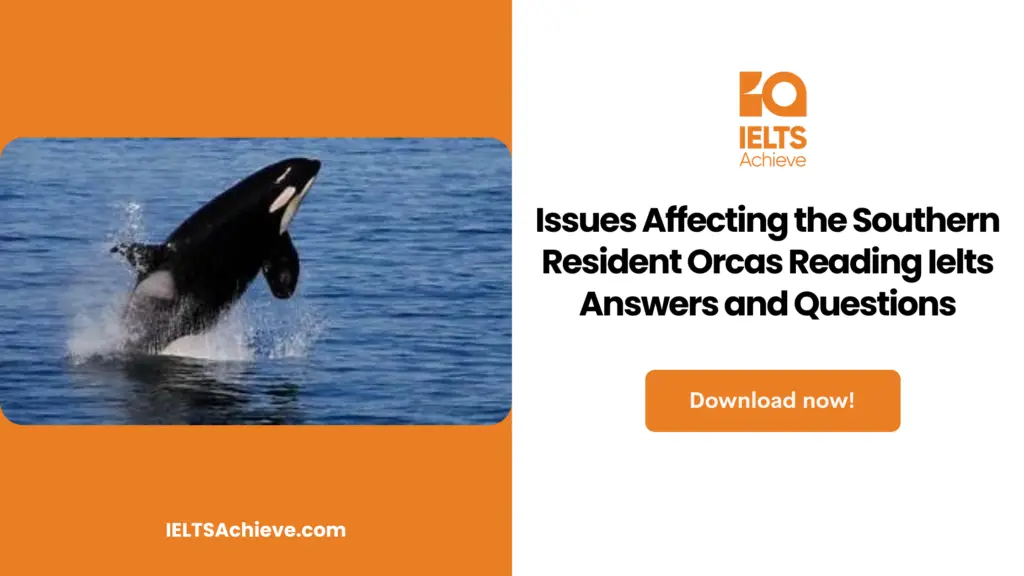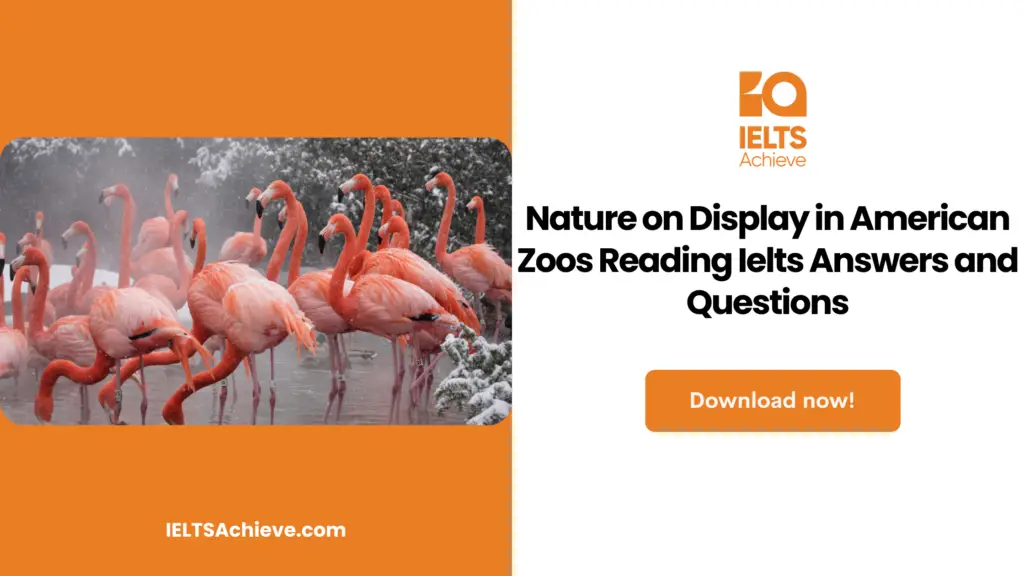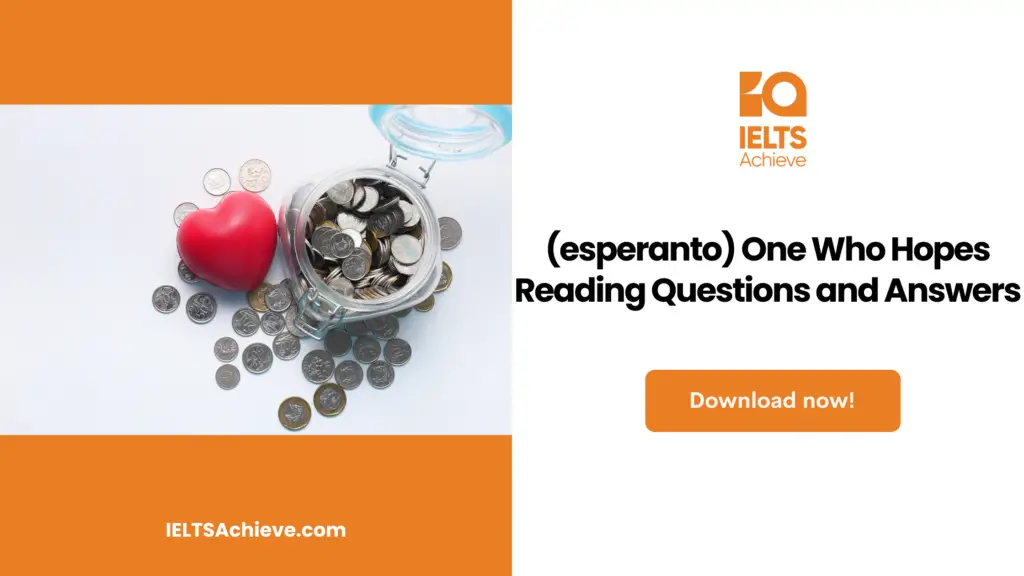The Blog post contains the following IELTS Reading Questions:
- IELTS Reading Flowchart Completion
- IELTS Reading Multiple Choice Questions
- IELTS Reading Matching Headings
Stay informed and prepared for success – Explore our comprehensive Reading Test Info page to get valuable insights, exam format details, and expert tips for mastering the IELTS Reading section.
IELTS Reading Passage: issues affecting the southern resident orcas

Issues Affecting the Southern Orcas
A
Orcas, also called as killer whales, are aggressive feeders, which means they will take a multiplicity of various prey species. J, K, and L pods (specific groups of orcas found in the region) are nearly solely fish eaters. Some analyses show that up to 90 percent of their diet is salmon, with Chinook salmon being by far their favorite. During the last 50 years, hundreds of wild runs of salmon have vanished due to environmental loss and overfishing of wild stocks. Many of the vanished salmon stocks are the winter runs of Chinook and coho. While the live stocks have probably been enough to comfort the resident pods, numerous runs that have been lost were doubtless traditional resources favored by the resident orcas. This may be affecting the whales’ nourishment in the winter and may need them to swap their motif of movement in order to search for food.
Other analyses with tagged whales have shown that they usually dive up to 800 feet in this area.Analysts are inclined to think that during bottomless dives the whales may be feeding on bottomfish. Bottomfish species in this area would cover flatfish, bullfish, Ophiodon, and greenling. Researchers assess that today’s Ophiodon population in northern Puget sound and the strait of Georgia is only 2 percent of what it was in 1950. The norm size of bull fish in the recreational catch has also decreased by some inches since the 1970s, which is symptomatic of overfishing. In a few locations, certain bull fish species have vanished completely. So even if bottomfish are not a main food resource for the whales, the present low numbers of obtainable fish increases the pressure on orcas and all oceanic animals to find food. (for more details on bottomfish see the San Juan Country Bottomfish Recovery Program).
B
Poisonous stuff gather in lofty concentrations as they move up the food chain. Due to orcas are the top vampire in the ocean and are at the top of some various food chains in the habitat, they are conducive to be more affected by pollutants than other sea animals. Scrutiny of helpless killer whales have shown some exceedingly high levels of lead, mercury and PCBS. Deserted oceanic poisonous waste dumps and present levels of firm and human waste pollution of the inland waters probably presents the most serious threat to the continuous survival of this orca population. Adversely, the total treatment to this huge issue would be broad societal changes on numerous fronts. However because of the fact that orcas are so famous, they may be the best type to use as a center in bringing about the numerous swaps that are required to be made in order to keep the oceanic habitat as a whole from further noxious poisoning’.
C
The water around the San Juan Island is exceedingly busy because of international trading shipping, fishing, whale watching, and cruisers. On a busy weekend day in the summer, it is not unusual to see many vessels in the neighborhood of the whales as they travel through the area. The possible collision from all this boat traffic with consideration to the whales and other oceanic animals in the area could be huge. The surfacing and breathing space of oceanic birds and mammals is a censorious aspect of their environment, which the animals must deliberately deal with on a moment-to moment basis all over their lifespan. With all the sailing activity in the neighborhood, there are three ways in which surface collisions are most likely to affect oceanic animals:(a) impact, (b) impact avoidance, and (c) exhaust emission in breathing pockets.
The first two collisions are very clear and don’t just apply to boats with motors. Canoes even present an issue here due to they’re so quiet, oceanic animals, busy hunting and feeding under the surface of the water, may not be conscious of the fact that there is a canoe above them and literally hit the bottom of it as they surface to breathe. The third collision is one most people don’t even think of. When there are many boats in the area, particularly loafing boats, there is ample carbon monoxide gas being erected out on the surface of the water. When the whale comes up to a nice huge breath of “pure” air, it alternatively gets a nice big breath of carbon monoxide gas. It’s difficult to tell how highly this affects the animals, but think how breathing polluted air affects us (i.e., smoke in large cities like Los Angeles, breathing the disgusting air while sitting in traffic jams, etc).
D
Alike to surface collisions, a prime origin of acoustic pollution for this population of orcas would also be obtained from the accumulating underwater noise of vessel traffic. For beluga, the sub-aquatic sound habitat is may be the most censorious part of their sensory and observable lives. Orcas liaise with each other over short and long gaps with a diversity of clicks, tweet, creak, and whoosh, along with using bio sonar to locate prey and to navigate. They may also rely on submissive listening as a prime sensory source. The incessant collisions from noise pollution would not likely show perceptible behavioral changes in the environment use, but rather as sensorial damage or decreasing in population health. A new analyst at The Whale Museum called the SeaSound Remote Sensing Network has begun studying sub-aquatic acoustics and its relationship to orca communication.
Unlock your full potential in the IELTS Reading section – Visit our IELTS Reading Practice Question Answer page now!
Recommended Questions:
Renewable Energy IELTS Reading Question with Answer
IELTS Reading Questions: issues affecting the southern resident orcas
Questions 1-4
- Reading Passage 3 has four sections (A-D). Choose the most suitable heading for each section from the list of headings below.
- Write the appropriate numbers (i-vii) in boxes 1-4 on your Answer Sheet
- There are more headings than sections, so you will not use all of them.
List of Headings
1 Section A i Top Ocean Predators
2 Section B ii Toxic Exposure
3 Section C iii Declining Fish Populations
4 Section D iv Pleasure Boating in the San Juan Islands
v Underwater Noise
vi Smog in Large Cities
vii Impact of Boat Traffic
viii Impact of Boat Traffic
Ready to conquer Matching Headings questions? Click here to learn essential tips and techniques for matching headings accurately to paragraphs or sections in the IELTS Reading section.
Questions 5-6
For each question, choose the appropriate letter A-D and write it in boxes 5 and 6 on your Answer Sheet
5 Killer whales (orcas) in the J, K, and L pods prefer to eat
A halibut.
B a type of salmon.
C a variety of animals.
D fish living at the bottom of the sea.
6 Some groups of salmon have become extinct because
A they have lost places to live.
B whales have eaten them.
C they don’t get good nutrition.
D the winters in the area are too cold.
Ready to improve your performance in Multiple Choice Questions (MCQs)? Click here to access our comprehensive guide on how to tackle MCQs effectively in the IELTS Reading section.
Questions 7-14
Complete the chart below. Choose NO MORE THAN THREE WORDS for each answer. Write your answers in boxes 7-14 on your Answer Sheet.
| Cause | Effect |
| Scientists believe some whales feed 7 _______ | These whales dive very deep. |
| Scientists believe that the area is being overfished | Rockfish caught today are 8 _____ than rockfish caught in the past. |
| Orcas are at the top of the ocean food chain. | 9_______ affects orcas more than it does other sea animals. |
| Orcas are a 10_________ species. | We can use orcas to make society aware of the problem of marine pollution. |
| People enjoy boating, fishing, and whale watching in the San Juan Islands. | On weekends there are 11_______ near the whales. |
| Kayaks are 12 ___________ | Marine animals hit them when they come up for air. |
| A lot of boats beep their motors running. | Whales breathe 13 ___________ |
| Boats are noisy. | Whales have difficulty 14________ |
Boost your performance in Summary, Notes, Table, and Flowchart Completion tasks. Click here to explore our detailed guide and learn how to effectively complete summaries, notes, tables, and flowcharts in the IELTS Reading section.
Unlock your full potential in the IELTS Reading section – Visit our IELTS Reading Practice Question Answer page now!
Recommended Questions:
Renewable Energy IELTS Reading Question with Answer
Issues affecting the southern resident orcas Reading Answers
1. Answer: iii
2. Answer: ii
3. Answer: vii
4. Answer: v
5. Answer: B
6. Answer: A
7. Answer: (on) bottomfish
8. Answer: less
9. Answer: pollution
10. Answer: popular
11. Answer: numerous boats/vessels
12. Answer: quiet
13. Answer: exhaust fumes
14. Answer: communicating(with others)

We hope you found this post useful in helping you to study for the IELTS Test. If you have any questions please let us know in the comments below or on the Facebook page.
The best way to keep up to date with posts like this is to like us on Facebook, then follow us on Instagram and Pinterest. If you need help preparing for the IELTS Test, join the IELTS Achieve Academy and see how we can assist you to achieve your desired band score. We offer an essay correction service, mock exams and online courses.

